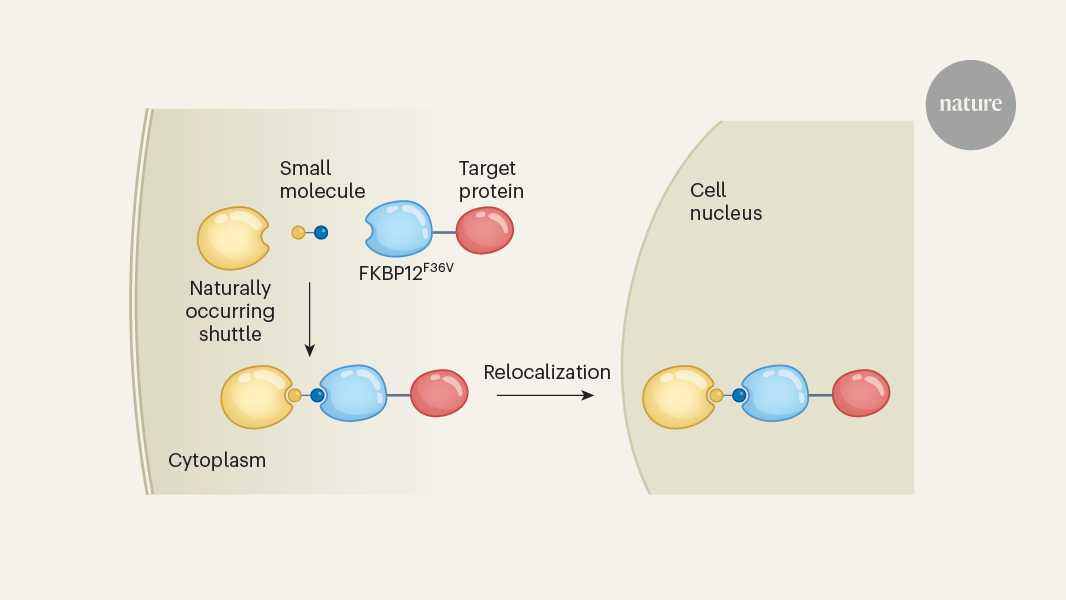Small Molecules Facilitate Protein Relocation to Treat Cellular Mislocalization Disorders
المفاهيم الأساسية
Small molecules can help relocate misplaced proteins by facilitating their interactions with shuttle proteins that transport them between the cytoplasm and nucleus.
الملخص
The article discusses how disruptions to proper protein localization within cells can underlie various diseases, such as cancers and neurological disorders. The researchers report the discovery of small molecules that can facilitate the relocation of misplaced proteins by enabling their interactions with "shuttle" proteins. These shuttle proteins are able to transport the mislocalized proteins between the cell's cytoplasm and nucleus.
The key highlights are:
- Cells have a network of biological regulators that direct proteins to their appropriate cellular compartments.
- Disruptions to proper protein localization can lead to diseases like cancer and neurological disorders.
- The researchers identified small molecules that can help relocate misplaced proteins.
- These small molecules work by enabling the misplaced proteins to interact with shuttle proteins that can transport them between the cytoplasm and nucleus.
- This provides a potential therapeutic approach to address cellular mislocalization disorders by using small molecule modulators of protein trafficking.
تخصيص الملخص
إعادة الكتابة بالذكاء الاصطناعي
إنشاء الاستشهادات
ترجمة المصدر
إلى لغة أخرى
إنشاء خريطة ذهنية
من محتوى المصدر
زيارة المصدر
www.nature.com
Small molecules help misplaced proteins hitchhike around cells
الإحصائيات
Disruptions to protein localization underlie various diseases, such as cancers and neurological disorders.
Small molecules can relocate misplaced proteins by facilitating their interactions with 'shuttle' proteins that move the misplaced protein between the cell cytoplasm and nucleus.
اقتباسات
"A network of biological regulators in the cell directs proteins to their appropriate cellular compartments."
"Disruptions to protein localization underlie various diseases, such as cancers and neurological disorders."
الرؤى الأساسية المستخلصة من
by Robert Yvon في www.nature.com 09-18-2024
https://www.nature.com/articles/d41586-024-02802-x
استفسارات أعمق
What are the specific mechanisms by which the small molecules facilitate the interactions between misplaced proteins and shuttle proteins?
The small molecules identified by Ng et al. act as molecular chaperones that enhance the binding affinity between misplaced proteins and shuttle proteins, which are responsible for transporting proteins between the cytoplasm and the nucleus. These small molecules likely function by stabilizing the conformation of the misplaced proteins, making them more amenable to interaction with shuttle proteins. Additionally, they may induce conformational changes in the shuttle proteins themselves, increasing their ability to recognize and bind to the target proteins. This interaction is crucial for the proper localization of proteins, as it allows for the effective translocation of proteins to their designated cellular compartments. By promoting these interactions, the small molecules can effectively redirect proteins that would otherwise accumulate in incorrect locations, thereby restoring normal cellular function and potentially mitigating the effects of diseases associated with protein mislocalization.
How can this small molecule approach be applied to treat different types of cellular mislocalization disorders?
The small molecule approach can be applied to treat a variety of cellular mislocalization disorders, including cancers and neurological disorders, where protein mislocalization plays a significant role in disease pathology. For instance, in certain cancers, tumor suppressor proteins may be mislocalized to the cytoplasm instead of the nucleus, leading to uncontrolled cell proliferation. By using small molecules to facilitate the correct localization of these proteins, it may be possible to restore their function and inhibit tumor growth. Similarly, in neurological disorders such as Alzheimer's disease, mislocalized proteins can contribute to neurodegeneration. Small molecules that promote the proper trafficking of these proteins could help maintain neuronal health and function. Furthermore, this approach could be tailored to target specific proteins involved in various diseases, allowing for personalized therapeutic strategies that address the underlying mechanisms of protein mislocalization.
What other cellular processes or pathways could be targeted to modulate protein localization and trafficking for therapeutic benefit?
In addition to the small molecule approach, several other cellular processes and pathways can be targeted to modulate protein localization and trafficking for therapeutic benefit. One potential target is the ubiquitin-proteasome system, which regulates protein degradation and can influence protein levels and localization. By manipulating this pathway, it may be possible to enhance the stability of proteins that are prone to mislocalization. Another avenue is the endosomal-lysosomal pathway, which plays a critical role in the sorting and trafficking of proteins within the cell. Targeting this pathway could help redirect mislocalized proteins back to their proper compartments. Additionally, signaling pathways that govern cytoskeletal dynamics, such as those involving actin and microtubules, could be modulated to improve the transport of proteins to their intended locations. Overall, a multifaceted approach that combines small molecules with other therapeutic strategies targeting these pathways could provide a robust framework for addressing protein mislocalization disorders.
0
